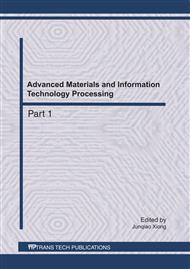[1]
F. Monary, D. Gatica-Perez: PLSA-based image auto-annotation: constraining the latent space. Proceedings of the 12th annual ACM international conference on multimedia, pp.348-351, (2004).
DOI: 10.1145/1027527.1027608
Google Scholar
[2]
D. Blei, A. Ng, M. Jordan: Latent dirichlet allocation. Journal of Machine Learing Research, pp.993-1022, (2003).
Google Scholar
[3]
C. Dance, J. Williamowski, L. Fan, C. Bray, G. Csurka: Visual categorization with bags of keypoints. ECCV workshop on statistical learning in computer vision, (2004).
Google Scholar
[4]
F. Jurie, B. Triggs: Creating efficient codebooks for visual recognition. IEEE international conference on computer vision, pp.604-610, (2005).
DOI: 10.1109/iccv.2005.66
Google Scholar
[5]
F. Li, P. Perona: A bayesian hierarchical model for learning natural scene categories. CVPR, pp.524-531(2005).
Google Scholar
[6]
C. Li, F. Li: Spatially coherent latent topic model for concurrent object segmentation and classificaton. Proceedings of IEEE International Conferenct on Computer Vision, pp.1-8, (2007).
DOI: 10.1109/iccv.2007.4408965
Google Scholar
[7]
L. Diane, V. Jakob, J. Frederic: Category level object segmentation by combining bag-of-words models with dirichlet processes and random fields. International Journal Computer Vision, pp.238-253, (2010).
DOI: 10.1007/s11263-009-0245-x
Google Scholar
[8]
F. Li, R. Fergus, P. Perona: Learning generative visual models from few training examples: An incremental Bayesian approach tested on 101 object categories. CVPR Workshop on Generative Model Based Vision, (2004).
DOI: 10.1109/cvpr.2004.383
Google Scholar
[9]
A. Torralba, K. P. Murphy, W. T. Freeman: Sharing features: Efficient boosting procedures for multiclass object detection. IEEE Conference on Computer Vision and Pattern Recognition, Vol. 2, pp.762-769, (2004).
DOI: 10.1109/cvpr.2004.1315241
Google Scholar
[10]
J. Shi, J. Malik: Normalized cuts and image segmentation. IEEE Transation Pattern Anal. Mach. Intell., pp.888-905, (2000).
DOI: 10.1109/34.868688
Google Scholar
[11]
K. Mikolajczyk, C. Schmid: Scale and affine invariant interest point detectors. International Journal of Computer Vision, pp.63-86, (2004).
DOI: 10.1023/b:visi.0000027790.02288.f2
Google Scholar
[12]
J. Matas, O. Chum, M. Urban, T. Pajdla: Robust wide baseline stereo from maximally stable extremal regoins. British Machine Vision Conference, pp.384-393, (2002).
DOI: 10.5244/c.16.36
Google Scholar
[13]
D. G. Lowe: Distinctive image features from scale-invariant keypoints. International Journal of Computer Vision, pp.91-110, (2004).
DOI: 10.1023/b:visi.0000029664.99615.94
Google Scholar
[14]
R. Neal: Markov chain samling methods for Diriclet process mixture model. Technical Report 9815, University of Toronto, Department of Staitistics, (1998).
Google Scholar
[15]
A. Gelman, J. B. Carlin, H. S. Stern, D. B. Rubin: Bayesian Data Analysis. Chapman & Hall, (2004).
Google Scholar
[16]
M. T. Orchard, Bounman: Color quantization of images. IEEE Transations on Signal Processing, pp.2677-2690, (1991).
Google Scholar


